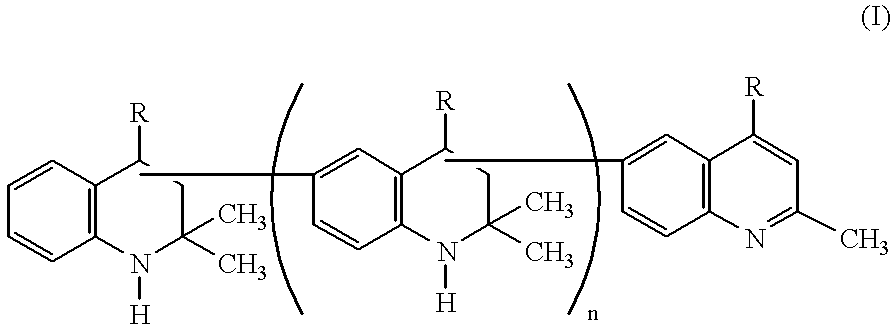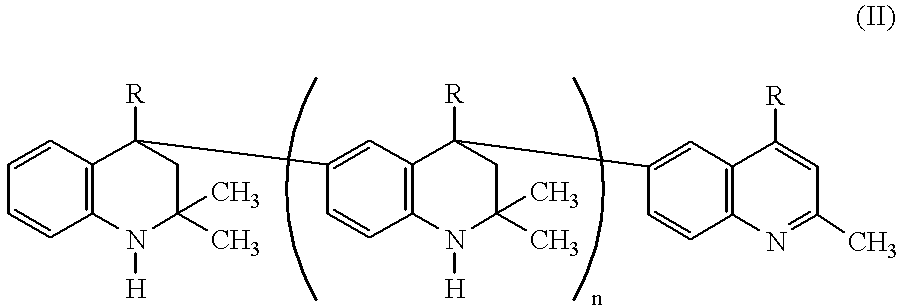Lubricating compositions containing aromatized 1,2-dihydro-2,2,4-trimethylquinoline polymers
- Summary
- Abstract
- Description
- Claims
- Application Information
AI Technical Summary
Benefits of technology
Problems solved by technology
Method used
Image
Examples
example 1
For evaluation of thermal stability, several lubricating compositions were prepared and evaluated. Sample A contained formulated diester base oil (XR No. 2437-RT manufactured by Quaker USA) and served as control. Sample B contained the formulated diester base oil and two weight percent of AGERITE.RTM. MA (aromatized 1,2-dihydro-2,2,4-trimethylquinoline polymer with predominantly 2 to 6 monomer units). Sample C contained the formulated diester base oil and two weight percent of VANLUBE.RTM. RD (a non-aromatized 1,2-dihydro-2,2,4-trimethylquinoline composed of dimer and trimer units) and served as a comparative sample.
Thermal stability was evaluated by a modified ASTM D2070-91 test for determining the thermal stability of oil based compositions. The test is known as the Cincinnati Milacron method. Copper and steel rods in contact with the oil were evaluated for appearance and weight loss after 168 hours at 135.degree. C. Sludge was determined by filtering oil through No. 41 Whatman pa...
example 2
The high temperature stability of base oils containing the aromatized and non-aromatized TMDQ polymers was evaluated. Lubricating compositions were prepared using the TMDQ polymers described in Example 1 in varying concentrations. The thermal stability of compositions was evaluated using the standard ICI thermal stability test, which entailed heating samples of the lubricating compositions at 200.degree. C. in 150 mL beakers with a steel coupon for 24 hours. The composition of the samples and the results of the thermal stability tests are listed in Table 4.
From Table 4, it is readily evident that the lubricating compositions containing the aromatized TMDQ polymers outperformed lubricating compositions containing the non-aromatized TMDQ polymers. For example, at 1.0 wt. % additive, the composition containing the aromatized polymer exhibited a weight loss of 59.2 while the composition containing the non-aromatized polymer exhibited a weight loss of 63.5. At 2.0 wt. % additive, a more ...
PUM
| Property | Measurement | Unit |
|---|---|---|
| Percent by mass | aaaaa | aaaaa |
| Percent by mass | aaaaa | aaaaa |
| Percent by mass | aaaaa | aaaaa |
Abstract
Description
Claims
Application Information
 Login to View More
Login to View More - R&D
- Intellectual Property
- Life Sciences
- Materials
- Tech Scout
- Unparalleled Data Quality
- Higher Quality Content
- 60% Fewer Hallucinations
Browse by: Latest US Patents, China's latest patents, Technical Efficacy Thesaurus, Application Domain, Technology Topic, Popular Technical Reports.
© 2025 PatSnap. All rights reserved.Legal|Privacy policy|Modern Slavery Act Transparency Statement|Sitemap|About US| Contact US: help@patsnap.com



